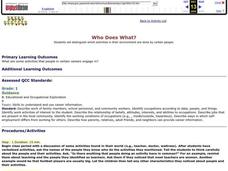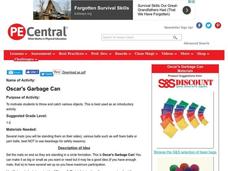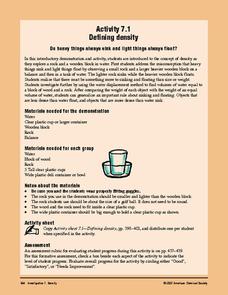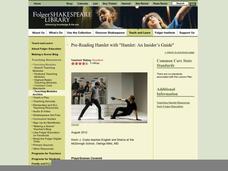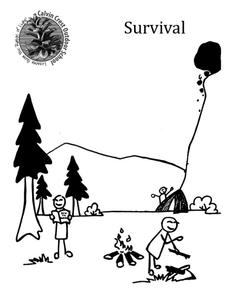Curated OER
What About Pumpkins
Second graders read 'Big Pumpkin' by Eric Silverman. In teams of 'pumpkin investigators', using real pumpkins, they discover how a pumpkin feels and smells, how much one weighs, and determine which group has the largest pumpkin.
Curated OER
Science-Unit on Matter-Gases
First graders understand that gases take up space even though you can't see or smell it. This is done through many experiments like trapping air in different sized bags, using balloons and plastic bottles, and blowing bubbles. They...
Curated OER
Frequency vs. Size
Students identify and interpret sound as a vibration and what period and frequency are. They also divide the various types of objects so that all objects are explored and the procedures are determined by the students.
Finally, students...
Curated OER
Living Organisms
Third graders examine pond water samples using hand lenses while working in small groups. They find specimens of living organisms in the water samples. Finally, the draw a picture of the organisms and label them using descriptive...
Curated OER
Properties of Materials
In this material properties worksheet, students complete 6 activities in which they learn about and explore the differences between materials and properties. They collect objects and list off the materials and properties, answer...
Curated OER
"Spooktacular Patterns" - A Math Unit for October
Pupils extend a pattern using everyday objects. They use sound and objects to make a pattern
Curated OER
Mud Fossils
Students create their own fossils in an activity using plaster of paris and a variety of objects which can be fossils, e.g. chicken bones, twigs, shells, etc. After making their fossils, they allow them to dry and discuss time and its...
Curated OER
Ocean Floor
Students identify ocean floor features. In this earth science lesson, students predict the object inside a close box to make them realize the difficulties scientists faced then. They label the different zones of the ocean floor after the...
Curated OER
Who Does What?
First graders examine activities that people in various careers engage in. They identify and compare/contrast various careers, and participate in a matching game that matches people to an object.
Curated OER
Oscar's Garbage Can
Students are arranged in a circle with two students inside the circle. They try to clean out Oscar's garbage can while the ones outside the circle try to throw the objects back in.
Curated OER
What is a Pico?
Young scholars label objects in their classroom based on mass and volume using the metric system. They examine the relationship between the numerical value and the corresponding metric unit.
Curated OER
Alphabet, Vegetable, and Chicken Noodle Parachute Soup
Students throw in their letter or vegetable when the said object or letter is said by the teacher. They also explore how to make a parachute ripple and make waves.
Curated OER
Got Biodiversity?
Students examine the concept of biodiversity. Using the internet, they complete small activities in which they work together. Using the information they collected, they create a class book, make murals and write in their journals.
Curated OER
Shapes
Students identify attributes of different geometric shapes. In this geometry lesson, students view a PowerPoint presentation on shapes and use attribute blocks to examine the corners and edges of each shape. Students work together...
Curated OER
Fish and Clips
Youngsters test magnetic strength by measuring the mass of paper clips that they "hook" with a magnet. Your first and second graders should love the hands-on activities associated with this plan. The reproducible materials are quite good...
American Chemical Society
Defining Density
Three simple activities kick off a unit investigation of density. Your physical scientists make observations on the volume and mass of wood, water, and rocks, and make comparisons. Though this is written for grades three through eight,...
Curated OER
The Sun, Moon, and Our Solar System: Teacher/Student Notes
Introduce basic Earth and space science to your budding astronauts. This handout works in two ways, the first part provides information about the sun, moon, eclipses, and Earth to be read to or by the class. The second part is composed...
Folger Shakespeare Library
Pre-Reading Hamlet with "Hamlet: An Insider’s Guide"
Prove that Gertrude did kill Ophelia from practicing the word inflections activities with these pre-reading strategies for Hamlet. Thespians practice the line, “Is that your sandwich?” as they stress and accent different words, and...
Curated OER
Running an Elementary Book Club
Combine reading with fun in order to create lifelong, literary-minded learners who love to read.
English Enhanced Scope and Sequence
Identifying Synonyms
"Let the hunt begin!" As an introduction to synonyms, second graders generate a list of word pairs that have similar meanings. The words pairs are written on sentence strips, cut apart, shuffled, and distributed to class members who must...
Calvin Crest Outdoor School
Survival
Equip young campers with important survival knowledge with a set of engaging lessons. Teammates work together to complete three outdoor activities, which include building a shelter, starting a campfire, and finding directions in the...
Perkins School for the Blind
Treasure Hunt
On, over, and under are some very common prepositions; but how can you teach these concepts to children with visual impairments? Here, is one way. Kids will practice following verbal commands as they go on a classroom treasure hunt. They...
Curated OER
May the Force be with You -- All about Force and Gravity
Here is a fabulous set of teacher's notes that will make your next hands-on gravity and force lab fun and interesting. These notes provide you with three activities that allow children to make and test hypothesis regarding force,...
Laboratory for Atmospheric and Space Physics
Jupiter’s Relative Size
How do you properly illustrate the extreme size difference between two planets—Earth and Jupiter? With the help of jellybeans, of course! Create a scale model of Jupiter's mass compared to Earth using a fishbowl, 1,400 beans, and a...










